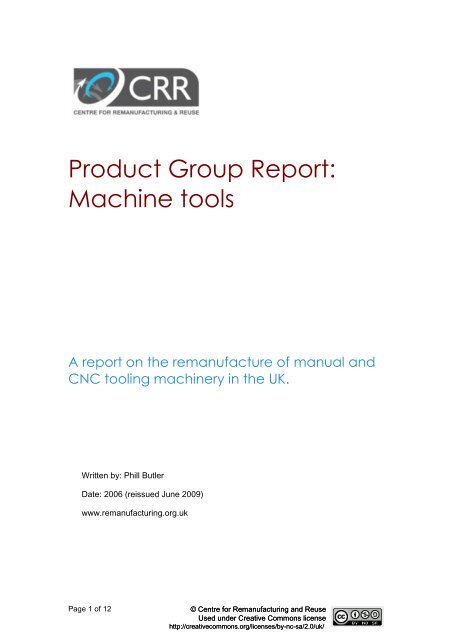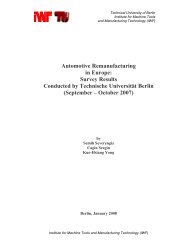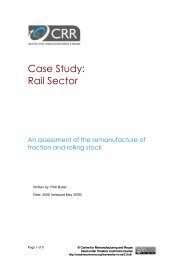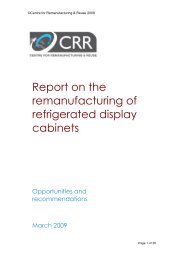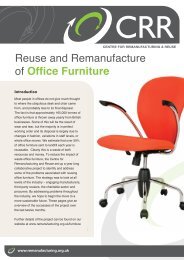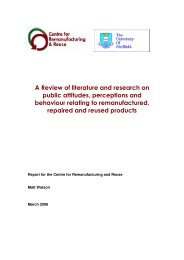Machine Tools - Centre for Remanufacturing & Reuse
Machine Tools - Centre for Remanufacturing & Reuse
Machine Tools - Centre for Remanufacturing & Reuse
Create successful ePaper yourself
Turn your PDF publications into a flip-book with our unique Google optimized e-Paper software.
Product Group Report:<br />
<strong>Machine</strong> tools<br />
A report on the remanufacture of manual and<br />
CNC tooling machinery in the UK.<br />
Written by: Phill Butler<br />
Date: 2006 (reissued June 2009)<br />
www.remanufacturing.org.uk<br />
Page 1 of 12<br />
© <strong>Centre</strong> <strong>for</strong> <strong>Remanufacturing</strong> and <strong>Reuse</strong><br />
Used under Creative Commons license<br />
http://creativecommons.org/licenses/by-nc-sa/2.0/uk/
Page 2 of 12<br />
© <strong>Centre</strong> <strong>for</strong> <strong>Remanufacturing</strong> and <strong>Reuse</strong><br />
Used under Creative Commons license<br />
http://creativecommons.org/licenses/by-nc-sa/2.0/uk/
Contents<br />
1 Overview 5<br />
2 The product 6<br />
3 Evolution rate 6<br />
4 Value 7<br />
5 Potential 8<br />
6 Policy options 9<br />
7 Model 10<br />
Page 3 of 12<br />
© <strong>Centre</strong> <strong>for</strong> <strong>Remanufacturing</strong> and <strong>Reuse</strong><br />
Used under Creative Commons license<br />
http://creativecommons.org/licenses/by-nc-sa/2.0/uk/
This page is intentionally blank.<br />
Page 4 of 12<br />
© <strong>Centre</strong> <strong>for</strong> <strong>Remanufacturing</strong> and <strong>Reuse</strong><br />
Used under Creative Commons license<br />
http://creativecommons.org/licenses/by-nc-sa/2.0/uk/
1 Overview<br />
<strong>Machine</strong> tools are an essential element of modern production facilities. They are<br />
employed in a wide range of industries, adding value directly or indirectly to<br />
products. Investment in machine tools requires confidence in the capital goods<br />
market, thus the global machine tool market is highly dependant on global<br />
economic and political trends. The downturn in global trade after 2001 saw the<br />
machine tool market decline sharply and, despite the massive growth of<br />
manufacturing seen in China and India, the sector is only just beginning to<br />
recover. The continued migration of production operations to lower wage<br />
economies, coupled with the greater productivity of single machines, has reduced<br />
the home market <strong>for</strong> machine tools in the UK. Since 2000, the UK stock of<br />
machine tools has steadily decreased by 6% per annum (Benchmark Report,<br />
2006).<br />
Over half the turnover from UK machine tool producers is due to export, although<br />
the UK also imports a similar value of equipment. The UK is believed to be the<br />
12 th largest producer of machine tools in the world, with the 15 th largest market<br />
(Gardner Publications Inc). It has historically been a strong exporter of high<br />
quality machine tools. Although budget Asian alternatives have made inroads into<br />
the cheaper end of the market, European, Japanese, and American products are<br />
still seen as superior in terms of quality. Developing markets in China and India<br />
have been slow to take advantage of the more expensive European machines,<br />
although the UK is now beginning to see more exports to Asia. There is also a<br />
strong export demand <strong>for</strong> used machinery that is no longer required in the UK.<br />
In terms of production, there are few large UK owned machine tool manufacturers<br />
remaining, with a number of <strong>for</strong>eign companies such as Yamazaki Mazak and<br />
Hardinge (Bridgeport) operating manufacturing facilities in the UK. Whilst most<br />
large OEMs offer a comprehensive support and parts service, very few offer full<br />
refurbishment or remanufacture. Smaller OEMs on the other hand are far more<br />
likely to offer some <strong>for</strong>m of remanufacture or reengineering. These firms usually<br />
produce a limited range of products, aimed at a particular manufacturing<br />
operation, and will work on machines from other manufacturers as well as their<br />
own.<br />
With the many OEMs ignoring the demand <strong>for</strong> second hand and reconditioned<br />
machines, a number of third party operators have emerged, offering repair and<br />
remanufacture. Some of these firms specialise in particular components such as<br />
CNC monitors or spindles, whilst others remanufacture entire machines. Some of<br />
these organisations <strong>for</strong>m alliances with well known OEMs such as Jones and<br />
Shipman, who manufacture grinding machines. With OEM parts commanding a<br />
high price, this is an attractive option <strong>for</strong> users of machine tools; large and small<br />
alike. There is also a thriving market <strong>for</strong> retro fitting of CNC systems to aging<br />
machines to boost their productivity to a level comparable to modern units. There<br />
has been a shift in the aerospace industry over the last 3 – 4 years towards<br />
opting to purchase re-engineered and remanufactured equipment rather than<br />
new, and this has boosted the UK remanufacturing industry significantly in some<br />
areas.<br />
Page 5 of 12<br />
© <strong>Centre</strong> <strong>for</strong> <strong>Remanufacturing</strong> and <strong>Reuse</strong><br />
Used under Creative Commons license<br />
http://creativecommons.org/licenses/by-nc-sa/2.0/uk/
Due to the extensive skill and knowledge base that the UK possesses in the<br />
machine tool sector, older British machines are regularly shipped back to the UK<br />
from developing economies <strong>for</strong> remanufacture. These machines will then be<br />
returned to their owner in “as new” condition, but at far less cost than a new unit.<br />
Some firms also offer an on-site remanufacturing service. This practice is<br />
particular popular <strong>for</strong> large lathes, mills and vertical borers. Smaller machines are<br />
normally replaced with cheaper imports from Asia and the Middle East.<br />
2 The product<br />
The overwhelming majority of machine tools are used to work metal, although<br />
they can of course be used on other materials. The Manufacturing Technologies<br />
Association, which represents the machine tool sector in the UK, defines a<br />
machine tool as: “a power driven machine, not portable by hand when in<br />
operation, which works material by cutting, <strong>for</strong>ming, physiochemical (or noncontact)<br />
machining, or a combination of these techniques”. Modern machine tools<br />
often incorporate a complex computer control system, known as CNC (computer<br />
numerical control).<br />
Vibrations are a source of error when machining and so must be avoided at all<br />
costs. To counter this, machine tools often have substantial cast iron structures to<br />
absorb vibration and provide stiffness to prevent the machine flexing under load.<br />
Modern machines may also have real-time feedback control systems that alter<br />
the tool path to take into account machine movement, vibration or tool wear. For<br />
extremely accurate operations, a temperature controlled environment may also<br />
be required. Operator safety is of course a paramount consideration, and all<br />
machines must be fitted with appropriate guards and safety cut-off devices.<br />
These must be retro-fitted to older machines to comply with current regulations,<br />
and owners who fail to do so may face prosecution.<br />
By the nature of their working environment, machine tools must be extremely<br />
rugged and reliable, as downtime is expensive. Many machines run 24hrs a day<br />
<strong>for</strong> years on end, needing very little manual intervention.<br />
3 Evolution rate<br />
The products created using machine tools are becoming ever more complex and<br />
demanding, and so today’s machine tools are becoming more accurate and<br />
reliable than ever be<strong>for</strong>e. New materials and computer modelling techniques are<br />
helping to optimise machine structure, whilst increased computer processing<br />
Page 6 of 12<br />
© <strong>Centre</strong> <strong>for</strong> <strong>Remanufacturing</strong> and <strong>Reuse</strong><br />
Used under Creative Commons license<br />
http://creativecommons.org/licenses/by-nc-sa/2.0/uk/
power and networked communication is allowing <strong>for</strong> improved monitoring and<br />
feedback systems on CNC units. The introduction of high speed machining<br />
techniques allows <strong>for</strong> lower tool <strong>for</strong>ces to be applied to the work piece, thus<br />
reducing machine and work piece distortion. There is also a move to reduce or<br />
eliminate the need <strong>for</strong> coolant, historically both bad <strong>for</strong> the environment and a<br />
non-value adding expense (up to 15% of total cost).<br />
In the drive <strong>for</strong> improved productivity, so called lights-out (unmanned) machining<br />
operations are becoming more popular, with machines being able to per<strong>for</strong>m a<br />
multitude of tasks without human intervention. This has seen the introduction of 6<br />
and 7 axis machines that rely on advanced feedback control rather than a<br />
traditional heavy-weight chassis <strong>for</strong> stability.<br />
For many applications however, this new technology is simply not required. The<br />
ability to retro-fit CNC technology to twenty or thirty year old machines means that<br />
<strong>for</strong> all but the most high tech, demanding operations, quality used machinery can<br />
still compete, particularly in lower wage economies where there is not such an<br />
emphasis on removing manual labour from the production process.<br />
In terms of energy efficiency, the deciding factor <strong>for</strong> machine tools is the electric<br />
motors that are used to provide the motive <strong>for</strong>ce. As more efficient motor<br />
technology emerges, older tools can be adapted to accept these newer designs.<br />
A new generation of permanent magnet rotor devices are beginning to be<br />
developed which offer improved efficiency and reduced size. Although these have<br />
not been incorporated into current machines, it is likely that machines in the future<br />
will all employ this technology. Linear motors are becoming widely used in higher<br />
end applications because of the improved accuracy and repeatability they offer.<br />
The rate and method by which coolant is applied will also affect the efficiency of<br />
an operation to a lesser extent, and again, this system can be upgraded on older<br />
machines as technology moves <strong>for</strong>ward.<br />
4 Value<br />
<strong>Machine</strong> tools represent a significant capital investment <strong>for</strong> companies. Some<br />
modern CNC machine centres can cost hundreds of thousands of pounds to<br />
purchase and install. Older tools there<strong>for</strong>e retain a residual value as a second<br />
hand or remanufactured item; they are attractive to companies who wish to<br />
reduce their required capital outlay. Large firms may also wish to buy used<br />
equipment <strong>for</strong> lower volume or backup production. Further more, lead-time on a<br />
remanufactured machine may be substantially less than a new one; some<br />
manufacturers have a delay of 12 months or more <strong>for</strong> production of some<br />
bespoke models.<br />
The heavy iron castings used in machine tool chassis and beds retains a<br />
significant value, even if all other components of the machine are replaced. They<br />
also represent a substantial amount of embodied energy. Some industry sources<br />
believe that 20 year old cutting beds are superior to modern items as the designs<br />
were more substantial and the quality of cast iron better. These castings are<br />
Page 7 of 12<br />
© <strong>Centre</strong> <strong>for</strong> <strong>Remanufacturing</strong> and <strong>Reuse</strong><br />
Used under Creative Commons license<br />
http://creativecommons.org/licenses/by-nc-sa/2.0/uk/
extremely robust and repair is simple; they can easily facilitate several cycles of<br />
reuse. Modern castings are generally lighter to reduce cost, and rely more on<br />
lower tool <strong>for</strong>ces and intelligent control feedback to maintain accuracy.<br />
Due to the rapid advancement of CNC technology, it is unlikely that a<br />
remanufactured machine tool would retain its original control unit. Although many<br />
tools do not require the very latest in CNC, it is likely that the controller would be<br />
replaced with a more up to date system. The CRT display unit could be retained if<br />
still working, although a remanufactured unit may be fitted to reduce the risk of<br />
warranty claims. There are companies who specialise in the remanufacture and<br />
repair of machine tool display units, so even damaged units may hold some<br />
residual value. OEM replacements are expensive, and may not be available <strong>for</strong><br />
older models.<br />
To ensure remanufactured machines can produce the required accuracy, any<br />
wearing components such as bearings, channels and spindles should be either<br />
replaced or remanufactured. Channels and spindles may be re-coated with<br />
materials such as Turcite® be<strong>for</strong>e grinding to their original tolerances, and so<br />
retain some of their value. Bearings will usually be replaced with new.<br />
Motors and cooling pumps represent the most significant energy consumers on<br />
machine tools and as such should be replaced with newer, more efficient items.<br />
As with all other components discarded during the remanufacturing process,<br />
these will retain a value as scrap and should be recycled in a responsible<br />
manner.<br />
5 Potential<br />
The UK has a strong remanufacturing industry base, with extensive skill and<br />
knowledge of the sector. However, owing mainly to the migration of industry to<br />
lower wage economies and the introduction of cheaper alternative products into<br />
the UK market, demand <strong>for</strong> machine remanufacture is falling. Niche sectors such<br />
as aerospace and steel are remaining healthy, with specialised re-engineering<br />
firms taking advantage of the current market stability. General engineering and<br />
automotive are on the decline however, which is having a negative impact on the<br />
internal UK machine tool industry as a whole. This is not to say that the market is<br />
beyond hope. Far from it; despite the highly publicised failures of car companies<br />
such as MG Rover, the automotive sector still accounts <strong>for</strong> around 40% of<br />
machine tool sales in the UK (MTA, 2006). Heavy industry is still a large<br />
consumer of new and remanufactured machines.<br />
<strong>Machine</strong>s of value below £25,000 are no longer economical to remanufacture<br />
when compared to cheap alternatives from the Far East. Re-engineering of<br />
larger, high value machines is more popular than ever, but many are destined <strong>for</strong><br />
overseas customers; there is a net flow of large machines out of the UK. The<br />
industry will find it increasingly difficult to acquire cores, with many firms are<br />
already experiencing a rising price <strong>for</strong> used machines, and sourcing cores from<br />
abroad as non are available in the UK. Well reputed, specialised firms can<br />
Page 8 of 12<br />
© <strong>Centre</strong> <strong>for</strong> <strong>Remanufacturing</strong> and <strong>Reuse</strong><br />
Used under Creative Commons license<br />
http://creativecommons.org/licenses/by-nc-sa/2.0/uk/
continue to operate in this environment as their expertise in the field justifies the<br />
extra cost of UK labour and transporting cores from overseas. Smaller firms<br />
however, who existed mainly to serve the UK market will find it increasingly<br />
difficult to compete. Offering remanufacture is no longer adequate to compete in<br />
the global market. Firms must display a capability to re-engineer machines, i.e.<br />
give them capability above that <strong>for</strong> which they were originally designed.<br />
Remanufacture can be carried out anywhere in the world, whereas the skill and<br />
knowledge required to design and fabricate a new machine or add CNC, based<br />
around an existing core, takes time to develop. This is what UK firms must aim to<br />
capitalise on in order to compete with firms operating closer to the eastern<br />
marketplace, with lower costs. Manufacturing is a global <strong>for</strong>ce, and firms who<br />
choose to target only one marketplace will find themselves at a distinct<br />
disadvantage.<br />
As machine tools become more complex, and firms demand more per<strong>for</strong>mance<br />
from their tools at low cost, there will be an increasing market <strong>for</strong> re-engineered<br />
machine tools of excellent quality. The global demand <strong>for</strong> machine tools is<br />
expanding, and looks set to <strong>for</strong> the <strong>for</strong>eseeable future. If the UK wishes to capture<br />
this market, it must nurture firms that are able to offer complete engineering<br />
solutions, not just remanufacture. Many machines currently being remanufactured<br />
in the UK are benefiting from the addition of CNC control. When these machines<br />
reach the end of their second lifetime in 10 or 20 years, the UK needs to be<br />
prepared to enhance them with the next generation of technology, and be at the<br />
<strong>for</strong>efront of that technology.<br />
6 Policy options<br />
Fiscal measures – Include remanufactured machine tools in the<br />
governments ECA scheme to encourage firms to use remanufactured<br />
machines rather then purchase new lower value imports.<br />
Product design – Stimulate academic and industrial research into<br />
machining so that the UK will retain its current position as an innovative<br />
<strong>for</strong>ce in the machining sector.<br />
Market Development – Help smaller British machine tool firms expand<br />
their market place to Europe and Asia by providing them with advice and<br />
in<strong>for</strong>mation on doing business with <strong>for</strong>eign companies, and the benefits<br />
that it can bring to their operation.<br />
Page 9 of 12<br />
© <strong>Centre</strong> <strong>for</strong> <strong>Remanufacturing</strong> and <strong>Reuse</strong><br />
Used under Creative Commons license<br />
http://creativecommons.org/licenses/by-nc-sa/2.0/uk/
7 Model<br />
Many firms interviewed stated that the number of orders they received varied<br />
quite dramatically from year to year, particularly <strong>for</strong> larger machines. The vast<br />
majority of firms are also relatively small, and thus there was no one firm or group<br />
of firms that could be seen as dominating the industry as in other sectors such as<br />
aerospace. The industry size has there<strong>for</strong>e been estimated from data collected<br />
from interviews and data from the MTA. Approximately 450 machines are<br />
remanufactured every year in the UK, with some of these being destined <strong>for</strong><br />
overseas customers. This equates to an industry turnover of £45 million,<br />
although it should be noted that individual contracts can have multi million pound<br />
costs, thus this turnover could be affected significantly by relatively few orders.<br />
Further complicating the issue is the enormous range of machine tools that are<br />
remanufactured. It is impossible to specify an “average” machine tool, with<br />
machines weighing from under a tonne to over 100 tonnes. For this model, a<br />
mass of 4 tonnes has been selected, which would represent a mid sized<br />
machining centre.<br />
Assumptions:<br />
A total industry turnover of £45 million<br />
A total output of 450 machines per annum<br />
The cost of a remanufactured machine is £100,000<br />
A machine mass of 4,000kg<br />
The CO 2E produced during the manufacture of a machine is 3.3kg CO 2E /<br />
kg machine.<br />
The CO 2E that could be saved by recycling a typical machine is 2.1kg<br />
CO 2E / kg of machine.<br />
Page 10 of 12<br />
© <strong>Centre</strong> <strong>for</strong> <strong>Remanufacturing</strong> and <strong>Reuse</strong><br />
Used under Creative Commons license<br />
http://creativecommons.org/licenses/by-nc-sa/2.0/uk/
Number of Units<br />
Table 1: Scenario assumptions<br />
Scenario<br />
Overall output and<br />
assumptions<br />
Ref The proportional<br />
level<br />
of<br />
remanufacture<br />
remains constant at<br />
2006 levels, with a<br />
decrease of 6% in<br />
line with UK<br />
machine stocks.<br />
A1 The proportional<br />
level<br />
of<br />
remanufacture<br />
increases at a rate<br />
of 0.2% pa in line<br />
with predicted UK<br />
machine tool<br />
production growth.<br />
A2 The proportional<br />
level<br />
of<br />
remanufacture<br />
increases at a rate<br />
of 2% pa which<br />
represents the<br />
predicted growth of<br />
the European<br />
machine tool<br />
industry.<br />
Possible policy<br />
Interventions<br />
Units<br />
Saved<br />
From<br />
Waste<br />
Stream<br />
Tonnes<br />
diverted<br />
From<br />
Waste<br />
Stream<br />
(kt)<br />
CO 2E<br />
Saved<br />
(kt)<br />
None 4713 19 23 471<br />
Encourage<br />
remanufactures<br />
to be proactive in<br />
seeking Foreign<br />
trade<br />
Same as A1<br />
together with<br />
greater emphasis<br />
on R&D<br />
7420 30 36 742<br />
8388 34 40 839<br />
£mil<br />
Spent<br />
On<br />
Reman<br />
Products<br />
Figure 1: Scenario outcomes<br />
Remanufacture of <strong>Machine</strong> <strong>Tools</strong><br />
700<br />
600<br />
500<br />
400<br />
300<br />
200<br />
Ref<br />
A1<br />
A2<br />
100<br />
0<br />
2006 2007 2008 2009 2010 2011 2012 2013 2014 2015 2016 2017 2018 2019 2020 2021<br />
Year<br />
Page 11 of 12<br />
© <strong>Centre</strong> <strong>for</strong> <strong>Remanufacturing</strong> and <strong>Reuse</strong><br />
Used under Creative Commons license<br />
http://creativecommons.org/licenses/by-nc-sa/2.0/uk/
Scenario Ref<br />
In this scenario, the UK has failed to capitalise on its knowledge and skill base.<br />
Remanufacture is only used to supply UK based customers. As the UK steadily<br />
reduces its stock of machine tools, so too does the work <strong>for</strong> remanufactures. By<br />
2020, only 190 machine tools are remanufactured each year, a fall of 260<br />
machines on 2006 figures. This represents 757 tonnes of material being diverted<br />
from the waste stream and a CO 2E saving of 854 tonnes each year, under half the<br />
current figures.<br />
Scenario A1<br />
Here, the UK has managed to capture sufficient <strong>for</strong>eign trade <strong>for</strong> remanufacture<br />
to grow steadily, despite a falling internal demand. The level of remanufacture<br />
has grown steadily at the same rate as the production of new equipment. By<br />
2020, 476 machines will be remanufactured each year, equating to 1903 tonnes<br />
of material being diverted from the waster stream and a CO 2E saving of 2284<br />
tonnes. This is an improvement of 1430 tonnes CO 2E over scenario Ref.<br />
Scenario A2<br />
In this scenario, the UK has succeeded in stimulating the growth of its machine<br />
tool industry as a whole, and as a consequence has managed to equal the<br />
growth seen in the rest of Europe. By 2020, 606 machines are being<br />
remanufactured each year, which saves 2375 tonnes of material from landfill and<br />
2850 tonnes of CO 2E from being produced. This is an improvement of almost<br />
2000 tonnes CO 2E over scenario Ref.<br />
Page 12 of 12<br />
© <strong>Centre</strong> <strong>for</strong> <strong>Remanufacturing</strong> and <strong>Reuse</strong><br />
Used under Creative Commons license<br />
http://creativecommons.org/licenses/by-nc-sa/2.0/uk/


